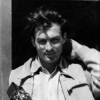Ernst Haas

Ernst Haas
Ernst Haaswas a photojournalist and a pioneering color photographer. During his 40-year career, the Austrian-born artist bridged the gap between photojournalism and the use of photography as a medium for expression and creativity. In addition to his prolific coverage of events around the globe after World War II, Haas was an early innovator in color photography. His images were widely disseminated by magazines like Life and Vogue and, in 1962, were the subject of the first single-artist exhibition of color...
NationalityAustrian
ProfessionPhotographer
Date of Birth2 March 1921
CountryAustria
A few words about the question of whether photography is art or not: I never understood the question.
The artist must express the summation of his feeling, knowing and believing through the unity of his life and work.
Is photography art?... The pure definition of the word 'art' alone is too vague today to break one's brain and soul about it. Let us take a little vacation from this word.
Every work of art has its necessity; find out your very own. Ask yourself if you would do it if nobody would ever see it, if you would never be compensated for it, if nobody ever wanted it. If you come to a clear ‘yes’ in spite of it, then go ahead and don’t doubt it anymore.
In every artist there is poetry. In every human being there is the poetic element. We know, we feel, we believe.
Through photography, both artist and scientist can find a common denominator in their search for the synthesis of modern vision in time, space and structure.
Photography is a bridge between science and art. It brings to science what it needs most, the artistic sense, and to art the proof that nothing can be imagined which cannot be matched in the counterpoints of nature.
The best pictures differentiate themselves by nuances...a tiny relationship - either a harmony or a disharmony - that creates a picture.
We can write the new chapters in a visual language whose prose and poetry will need no translation.
There is no formula. There are only confirmations to formulas which one has already discovered oneself.
The camera only facilitates the taking. The photographer must do the giving in order to transform and transcend ordinary reality. The problem is to transform without deforming. He must gain intensity in form and content by bringing a subjective order into an objective chaos.
Beware of direct inspiration. It leads too quickly to repetitions of what inspired you.
I have always felt better taking a risk than an easier route for what I believe in.
Refine your senses through the great masters of music, painting, and poetry.